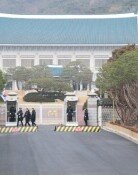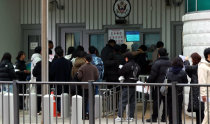Koreas home-grown unmanned drone reaches stratosphere
Koreas home-grown unmanned drone reaches stratosphere
Posted August. 12, 2015 07:40,

An unmanned aircraft flying in the stratosphere (at 13-20km altitude) for surveillance. It sounds like a scene from a sci-fi comic book but such an unmanned drone has been developed by a Korean research team.
According to Korea Aerospace Research Institute (KARI) researcher Kim Seung-ho on Tuesday, "EAV-3 (photo)," the high-altitude surveillance drone designed by the KARI team, has taken off in the aviation center at Goheung in South Jeolla Province and succeeded in flying at the altitude of 14.12 kilometers. This is the first time for a Korea-designed unmanned aircraft to fly in the stratosphere. As the air is thin in the stratosphere, it is not possible for general aircrafts to fly except for fighter planes.
High altitude surveillance drone is an aircraft, which soars to the sky and flies around powered by solar cells for several days at minimum or for several years at maximum to observe the land. Its biggest advantage is that it can be used as an alternative to a satellite. As the unmanned drone flies in the stratosphere between the atmosphere and the space, it can fly all the time regardless of weather conditions. While a satellite is able to observe Korea when it passes by the Korean peninsula several times a day, a high-altitude surveillance drone can watch the interested area for 24 hours a day.
Another merit is an affordable price. Compared to a satellite that floats at an altitude of 500 kilometers or higher, the drone flies close to the ground and a general camera installed on the drone can provide pictures as clear as those taken by a satellite. In comparison to the research spending of 237.3 billion won (approx. 200.99 million U.S. dollars) to develop a multi-purpose satellite (Arirang) 3A, it takes only 1 billion won (approx. 847,000 dollars) to build a high-altitude unmanned drone. Depending on each occasion, the drone can provide communication services. As it flies close to the ground, it is possible to establish free wireless internet services to adjacent areas. Because of this merit, global IT companies such as Google and Facebook are paying attention to drones.
As a high-altitude surveillance drone should fly under extreme conditions, such as one tenth of air density and 60 degrees below zero, it requires advanced control technology. The EAV-3 developed by the KARI research team has high-efficiency solar power cells on top of the wings. It has 20cm-wide wings but its weighs as light as 53kg by using the domestically-developed high-tech carbon fiber composite material on its wings.
Currently, the most advanced unmanned drone is the British-developed "Zephyr," which can fly non-stop for 2 weeks in the sky. The KARI team will further improve the EAV-3 and try to fly it for several days in the stratosphere.
Zephyr can fly for an extended time in the sky is thanks to the next-generation high-functioning lithium-sulphur batteries. The KARI team is currently looking for a joint research opportunity with domestic research teams, said Kim.
enhanced@donga.com




![[사설]“용인에 産團 있어야 할지”… 국가대계 흔드는 경망한 김성환](https://dimg.donga.com/c/138/175/90/1/wps/NEWS/IMAGE/2025/12/28/133051638.1.jpg)


